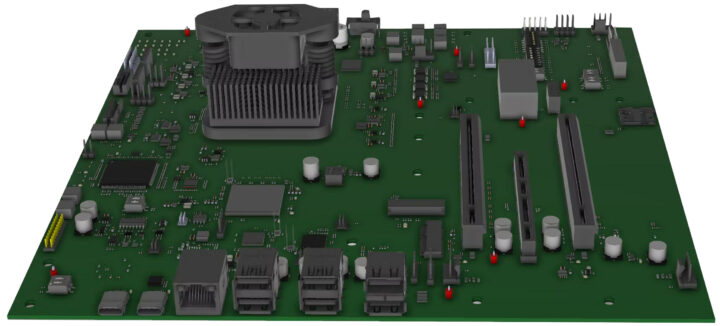SiFive HiFive Pro P550 RISC-V motherboard based on Intel “Horse Creek” quad-core SiFive Performance P550 processor will launch this summer with 16GB DDR5 memory, two PCIe expansion slots, Gigabit Ethernet networking, USB 3.x ports, and on-board graphics.
Intel Horse Creek platform was first revealed when SiFive unveiled the SiFive Performance P550 64-bit RISC-core with Cortex-A75 class performance in June 2021. The companies then demonstrated an internal Intel Horse Creek board with 8GB DDR5 and PCIe Gen5 at the Intel Innovation 2022 Developer Conference last October, and it looks like the 7nm RISC-V processor, manufactured with an Intel 4 process, will finally be available to developers this summer with the launch of the HiFive Pro P550 motherboard/development system.
HiFive Pro P550 preliminary specifications:
- SoC – Intel-SiFive Horse Creek SoC equipped with 4x SiFive Performance P550 RV64GBC RISC-V cores with a 13-stage, 3-issue, out-of-order (OoO) pipeline
- GPU – “On-board graphics” [Update: it appears to be SiliconMotion SM768 graphics processor. See comments section for details]
- System Memory – 16GB DDR5-5600
- Storage – 1x M.2 NVMe 2280 SSD socket (See Expansion section)
- Networking
- Gigabit Ethernet Port (One part of the product page even mentions 10GbE, likely through an expansion board)
- Optional WiFi/Bluetooth module through M.2 module (See Expansion section)
- USB – 6x USB 3.x/2.0 ports
- Management interface – OCP DC-SCM remote management ready interface
- Expansion
- 2x x16 PCIe Gen 3 expansion slots
- M.2 M-Key Slot (PCIe Gen 3) for NVMe 2280 SSD
- M.2 E-Key Slot (PCIe Gen 3) for Wi-Fi/Bluetooth module
- Note: The product page mentions support for PCIe Gen5
- Dimensions – 244 x 244 mm (microATX form factor)
Details are few and far between, with a couple of items unclear such as GPU, Ethernet speed, and PCIe version, but eventually, we’ll get a product brief, datasheets for the board and SBC, a getting started guide, as well as the schematics, 3D model, and BoM. So Intel and SiFive are working on making the motherboard open-source hardware once it is released.
The companies state the “highest performance RISC-V development board” is a “premium software development system ideal for developer desktop machines and rack-based build/test/deploy servers for RISC-V software development. RISC-V has no limits.”. But last October, the demo platform was clocked at 2.2 GHz, and if what we have here is indeed a quad-core Cortex-A75 processor @ 2.2 GHz, it will be the fastest RISC-V platform and offer a performance boost compared to the VisionFive 2 SBC (which I received yesterday), but still be ways behind mid-range Arm and entry-level x86 processors such as Rockchip RK3588 or Intel Jasper Lake processors.
We don’t have pricing information yet, but it’s clearly designed as a (Linux) development board that’s NOT optimized for cost, so the microATX motherboard won’t be cheap and should cost several hundred dollars, and possibly closer to $1,000. For reference, the previous generation HiFive Unmatched mini-ITX motherboard initially sold for $665. You may find a few more details and/or register your interest on the product page.
Via Hackster.io and thanks to TLS for the tip.

Jean-Luc started CNX Software in 2010 as a part-time endeavor, before quitting his job as a software engineering manager, and starting to write daily news, and reviews full time later in 2011.
Support CNX Software! Donate via cryptocurrencies, become a Patron on Patreon, or purchase goods on Amazon or Aliexpress






Maybe it uses Intel Gen12 Xe graphics. Too bad it’s a niche dev board.
The talk “Introducing the Highest Performance RISC-V Development Board: Next Generation SiFive HiFive – Sam Grove, SiFive & Nikhil Krishna Gopalakrishna, Intel” with some details is available here: https://www.youtube.com/watch?v=vAxkLeWA1sE
“On board graphics” is marked as “SM768”, which seems to be: https://www.siliconmotion.com/download/3PR/a/SM768_PB_EN_202004.pdf
SM768 seems like a reasonable choice for cheap low-power on board graphics from a hardware perspective. Unfortunately the three silicon motion drivers in the kernel are for older chips (sm501, sm72x and sm750) and for the old fbdev subsystem. There is an out of tree drm driver for sm750/sm768 at https://gitlab.com/sudipm/sm750/, which could presumably be merged through drivers/staging/, but that has not happened in the past five years since they started. Also, the chip only has a 2D display controller and a video decoder but no 3D GPU, which is what you normally need to have acceptable performance with Gnome… Read more »
Hi Arnd,
I tried adding that drm driver to staging. Greg was ok but the drm maintainers objected. There is also a new driver which will support SM750 and SM768, it will be much faster for it to be in mainline kernel if I can add it to staging then everyone can help in the cleanup.
Will it really be faster than the Sipeed Lichee board, which has the T-Head chips with the .7 version of the Vector extension?
(I can’t help but think that the Sipeed board is what’s wanted now, rather than another high priced developers’ board… idk )
Hard to say, but the 400 MHz higher clocks per core suggests it should be faster, but as not all RISC-V cores are created equally, we’re just going to have to wait and see. The C910 doesn’t seem to have L3 cache, which this has, suggeseting that this is a more advanced SoC design if some ways, despite lacking an integrated GPU.
Is “on-board graphics” not an integrated GPU?
🙂 Thanks TLS
C910 is roughly equivalent of Cortex-A73. Rvv 0.7 is nice, buy niche as no support in mainline compilers.
Why don’t they just make these with memory sockets?, so we can pop 128GB in it?